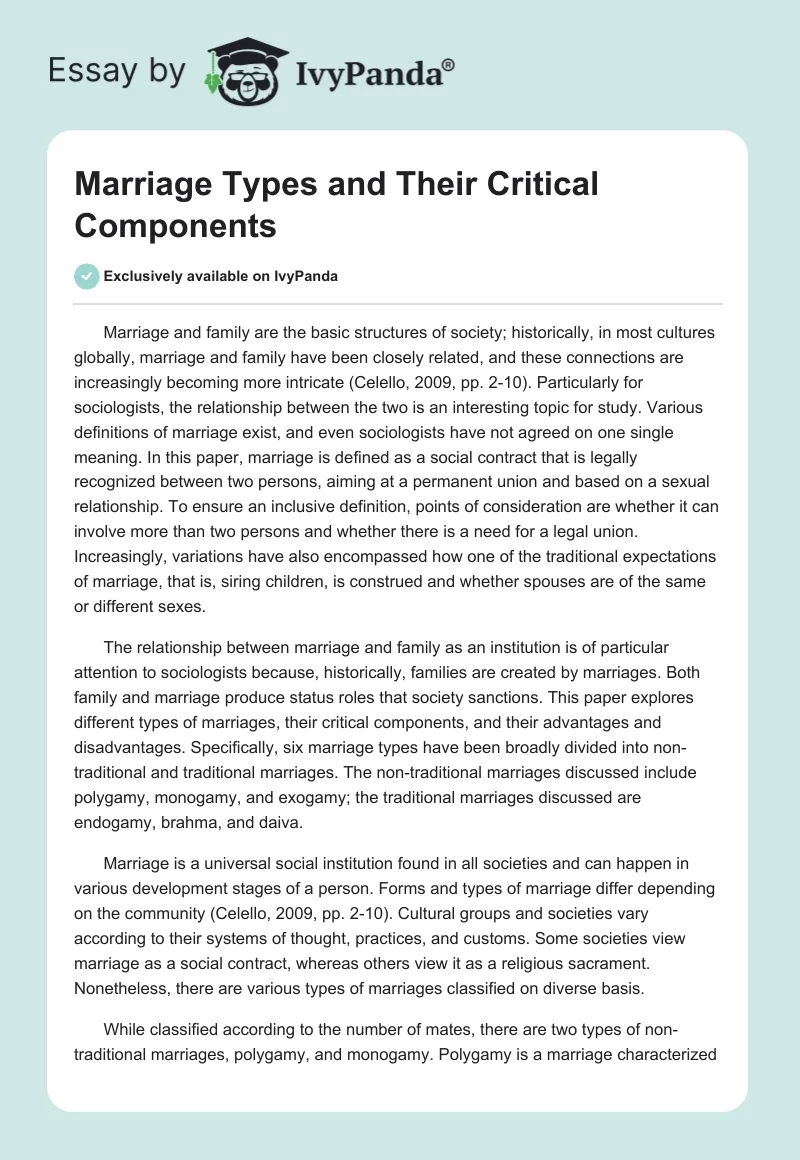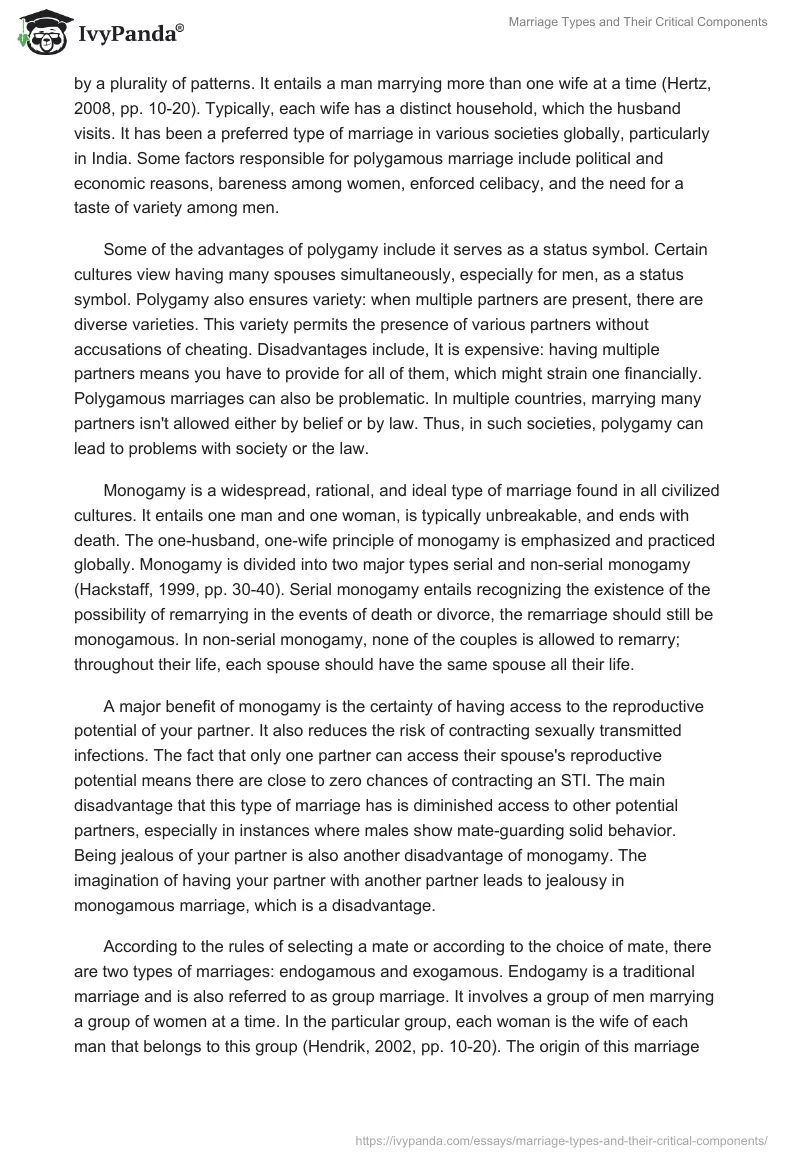Marriage and family are the basic structures of society; historically, in most cultures globally, marriage and family have been closely related, and these connections are increasingly becoming more intricate (Celello, 2009, pp. 2-10). Particularly for sociologists, the relationship between the two is an interesting topic for study. Various definitions of marriage exist, and even sociologists have not agreed on one single meaning. In this paper, marriage is defined as a social contract that is legally recognized between two persons, aiming at a permanent union and based on a sexual relationship. To ensure an inclusive definition, points of consideration are whether it can involve more than two persons and whether there is a need for a legal union. Increasingly, variations have also encompassed how one of the traditional expectations of marriage, that is, siring children, is construed and whether spouses are of the same or different sexes.
The relationship between marriage and family as an institution is of particular attention to sociologists because, historically, families are created by marriages. Both family and marriage produce status roles that society sanctions. This paper explores different types of marriages, their critical components, and their advantages and disadvantages. Specifically, six marriage types have been broadly divided into non-traditional and traditional marriages. The non-traditional marriages discussed include polygamy, monogamy, and exogamy; the traditional marriages discussed are endogamy, brahma, and daiva.
Marriage is a universal social institution found in all societies and can happen in various development stages of a person. Forms and types of marriage differ depending on the community (Celello, 2009, pp. 2-10). Cultural groups and societies vary according to their systems of thought, practices, and customs. Some societies view marriage as a social contract, whereas others view it as a religious sacrament. Nonetheless, there are various types of marriages classified on diverse basis.
While classified according to the number of mates, there are two types of non-traditional marriages, polygamy, and monogamy. Polygamy is a marriage characterized by a plurality of patterns. It entails a man marrying more than one wife at a time (Hertz, 2008, pp. 10-20). Typically, each wife has a distinct household, which the husband visits. It has been a preferred type of marriage in various societies globally, particularly in India. Some factors responsible for polygamous marriage include political and economic reasons, bareness among women, enforced celibacy, and the need for a taste of variety among men.
Some of the advantages of polygamy include it serves as a status symbol. Certain cultures view having many spouses simultaneously, especially for men, as a status symbol. Polygamy also ensures variety: when multiple partners are present, there are diverse varieties. This variety permits the presence of various partners without accusations of cheating. Disadvantages include, It is expensive: having multiple partners means you have to provide for all of them, which might strain one financially. Polygamous marriages can also be problematic. In multiple countries, marrying many partners isn’t allowed either by belief or by law. Thus, in such societies, polygamy can lead to problems with society or the law.
Monogamy is a widespread, rational, and ideal type of marriage found in all civilized cultures. It entails one man and one woman, is typically unbreakable, and ends with death. The one-husband, one-wife principle of monogamy is emphasized and practiced globally. Monogamy is divided into two major types serial and non-serial monogamy (Hackstaff, 1999, pp. 30-40). Serial monogamy entails recognizing the existence of the possibility of remarrying in the events of death or divorce, the remarriage should still be monogamous. In non-serial monogamy, none of the couples is allowed to remarry; throughout their life, each spouse should have the same spouse all their life.
A major benefit of monogamy is the certainty of having access to the reproductive potential of your partner. It also reduces the risk of contracting sexually transmitted infections. The fact that only one partner can access their spouse’s reproductive potential means there are close to zero chances of contracting an STI. The main disadvantage that this type of marriage has is diminished access to other potential partners, especially in instances where males show mate-guarding solid behavior. Being jealous of your partner is also another disadvantage of monogamy. The imagination of having your partner with another partner leads to jealousy in monogamous marriage, which is a disadvantage.
According to the rules of selecting a mate or according to the choice of mate, there are two types of marriages: endogamous and exogamous. Endogamy is a traditional marriage and is also referred to as group marriage. It involves a group of men marrying a group of women at a time. In the particular group, each woman is the wife of each man that belongs to this group (Hendrik, 2002, pp. 10-20). The origin of this marriage dates back to the Mesopotamian time, and today it is practiced in Africa, among some tribes of New Guinea, and in South Asian countries.
In Pakistan, mainly, endogamy is practiced based on castes and social groups. Basically, caste is a social class detached from others by hereditary rank, wealth, or professional distinctions. The advantage of endogamous marriages is that blood purity is protected because it is performed within their own caste group. It also offers the benefit of non-inferiority or superiority of two partners upon one another. The shortcomings of this marriage include: Jealously and hatred created with other groups and the fact that it leads to ethnocentric behavior.
Exogamous marriage is the opposite of endogamy; it involves persons marrying out of their groups and is mostly a non-traditional marriage. Exogamy sometimes has rules defining the outside group into which a person is necessitated to marry. Throughout cultures, the severity within which exogamous marriages are enforced varies and can differ from death to mild censure. Normally exogamy isn’t defined through religion, class, or ethnicity, instead, it is defined through class (Simmons, 2008, pp. 30-50). It is common amid groups that reckon lineage through the mother or the father alone.
These lineages are, in turn, grouped into moieties or clans. These are the locus of exogamy: marrying one’s own moiety or clan member. Thus, exogamy doesn’t guarantee that spouses will have no genetic relationship. The advantages of exogamy include; the fact that there’s a high poll of diverse genes and rare instances of birth defects and hereditary diseases. It also guarantees an increase in the relationship among kinship. Disadvantages include it may result in friction in marriage when exogamous partners are from cultures that clash more than expected, and there is reduced bloodline purity due to a diverse gene pool.
Traditionally societies also practiced marriage, and some two-common types of traditional marriages include Brahma and Daiva among the Hindus. Brahma is India’s most practiced marriage type and is regarded as the purest (Krause, 1993). It entails the father giving his daughter to a man of good learning and character. Typically, the daughter is adorned with ornaments, dressed opulently, and offered as a gift known as danam; The man of high learning and good character is referred to as srutisilavan. This type of marriage dates back to the Vedic era. Advantages of this type of marriage include, it involves maintenance of social decency.
The fact that it rewards the man for high learning leaves it as a marker of social progress (Krause, 1993). Disadvantages include leaving out the disadvantaged among the poor in the community as it rewards high social status. It also involves high levels of dealing with the spouse’s parents.
Daiva is a marriage slightly different from Brahma because the suitor is an official priest. It also didn’t stress special qualities such as the bridegroom’s good family background or good character among spouses (Cott, 2002). Typically, the bride does not go out looking for a bride. Instead, the bride’s parents search for a groom for their daughter. It is considered an inferior marriage to Brahma as the father benefits from utilizing her daughter as a sacrifice. Advantages include the fact that it is a formalized relationship it offers the spouses a sense of belonging. The two are also able to enjoy a better-quality life together (Cott, 2002). Disadvantages include it is considered degrading for a woman to search for a groom. It is also immoral to offer the priest a bride due to the poor nature of a family.
In conclusion, whereas marriage is a universal custom, societies differ. Some have more married individuals, whereas others have less. This disparity can help prove hypotheses such as under which circumstances marriages are an imperative component of society. Despite the fact, there is much research regarding the diverse types of marriage and conditions which favor each other. Apart from research on intimacy and aloofness in these areas, little has been done on the quality of marriages.
References
Celello, K. (2009). Making marriage work: A history of marriage and divorce in the twentieth century united states. The University of North Carolina press.
Cott, N. F. (2002). A history of marriage and the nation. Havard University Press. Web.
Hackstaff, K. B. (1999). Marriage in a Culture of Divorce. Temple university press.
Hendrik, H. (2002). Man and Wife in America:University Press A History. Cambridge, Mass.: Harvard University Press.
Hertz, R. (2008). Single by chance, mothers by choice: How women are choosing parenthood without marriage and creating the new American family. Oxford University Press.
Krause, H. D. (1993). Family values and family law reform. Journal of contemporary health law and policy. Web.
Simmons, C. (2008). Making Marriage Modern: Women’s Sexuality from the Progressive Era to World War II (Studies in the History of Sexuality). Oxford University Press.


